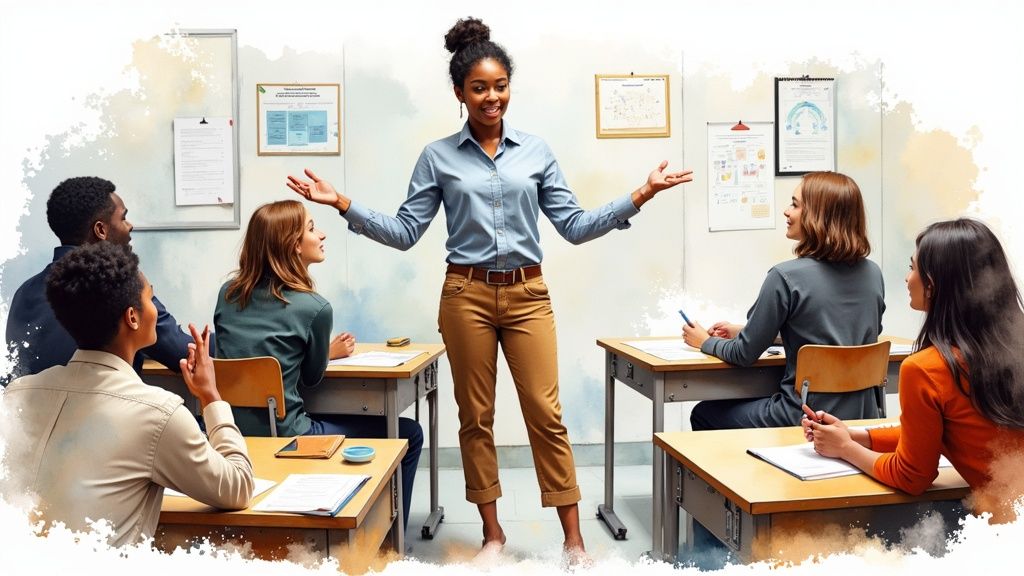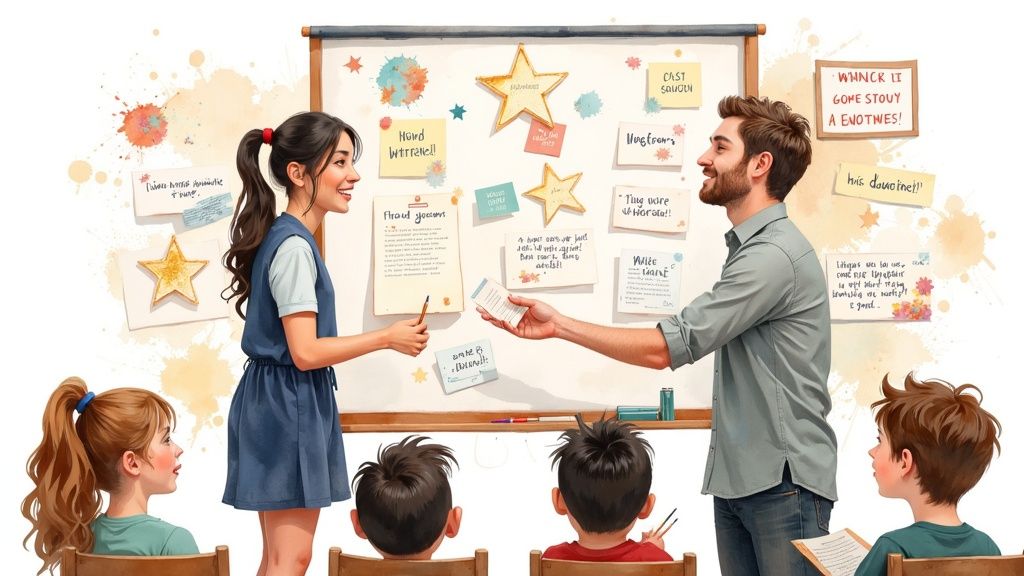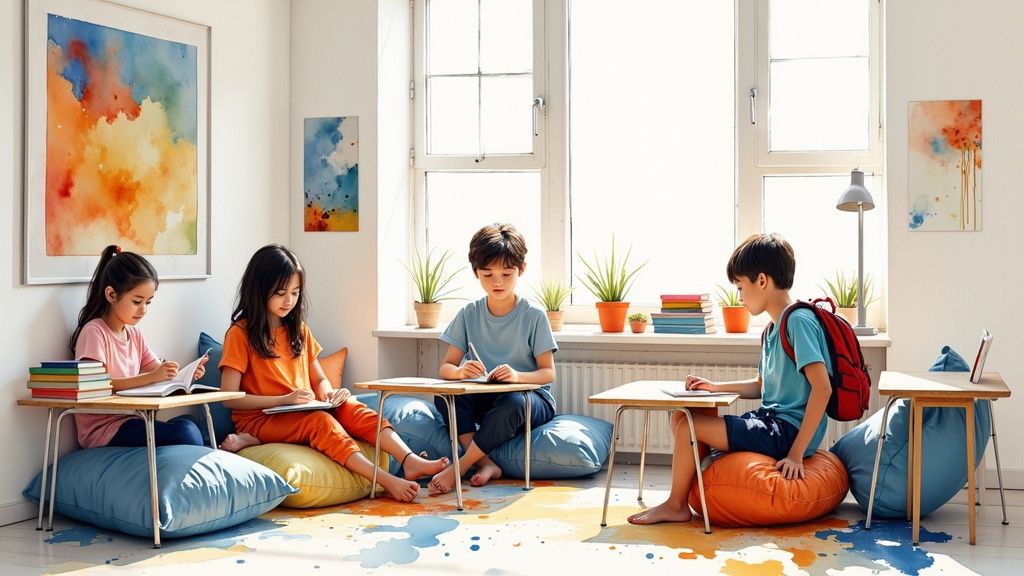Why Traditional Classroom Management Needs a Reset
The old approach to classroom management focused heavily on responding to disruptions after they happened, often with punishments that didn't address what was really causing the behavior. As students face new social and emotional challenges, these reactive methods no longer create the supportive learning environments students need to succeed. Teachers must adapt their strategies to better serve today's learners.
The Shift Towards Proactive Strategies
More teachers are moving away from just reacting to problems and instead working to prevent disruptions before they start. This means carefully planning lessons, clearly communicating expectations, and building meaningful connections with students from day one. The goal is creating a positive classroom culture where students feel respected and motivated to learn. Research shows this approach works – 85% of effective teachers have embraced these proactive methods and seen major improvements in their classroom dynamics.
Embracing Flexibility and Differentiation
One-size-fits-all discipline simply doesn't work because every student has unique needs and ways of learning. Modern classroom management recognizes this by offering flexible support and varied teaching methods. For example, teachers might give students choices in assignments or adjust their approach based on individual students' needs. Tools like Mastera help teachers deliver customized content that matches different learning styles and paces.
The Power of Relationship Building
Strong teacher-student relationships are essential for effective classroom management. When students feel their teacher truly understands and cares about them, they're more likely to participate positively in class. This goes beyond just being friendly – it means taking time to know students as individuals, listening to their perspectives, and consistently supporting their growth. The impact is clear: classrooms where teachers prioritize relationships see 33% more academic engagement and 75% fewer behavior issues.
These shifts represent a fundamental change in classroom management philosophy. Rather than just controlling behavior, the focus is on creating environments where students can grow academically and emotionally. This requires teachers to keep refining their methods, use helpful tools and resources, and invest in meaningful student connections. When done well, this approach creates better learning experiences for everyone involved.
Building Authentic Student Connections That Last
Strong classroom management starts with building real relationships with students. While rules and procedures matter, the connections you develop make the biggest impact on behavior and learning. This means going deeper than just memorizing names and interests – you need to understand what drives each student, what challenges they face, and how they learn best.
Understanding Your Students' Needs
Getting to know students as individuals is essential for building authentic connections. Just as plants need different care to thrive, each student has unique needs and preferences. Some do well with public recognition, while others prefer private encouragement. For example, an anxious student may need a quiet space to reset, but an outgoing student might excel in group activities. By recognizing these differences, you can adjust your approach for each student. This helps create more meaningful interactions and better outcomes.
Establishing Trust and Maintaining Boundaries
Students learn best when they feel safe and respected in the classroom. Building trust requires active listening, acknowledging feelings, and showing genuine care. At the same time, clear expectations and consistent follow-through remain important. Think of it like coaching – the best coaches build strong bonds with athletes while maintaining high standards. You can be understanding and supportive while still upholding classroom rules.
Practical Strategies for Connection-Building
Small daily actions make a big difference in connecting with students. Taking a few minutes to chat one-on-one about their interests or weekend shows you care about them as people. Giving students choices in their learning, whether picking project topics or activity formats, helps them feel valued and engaged. Tools like Mastera can support personalized learning that matches each student's style. Over time, these consistent efforts create an environment where students know they matter.
Overcoming Common Pitfalls
Building real connections takes work and flexibility. One common mistake is using the same approach with every student. What connects with one may not work for another. The key is finding the right balance between consistency and adaptability. You need firm classroom guidelines while being responsive to individual needs. By reflecting on what works and what doesn't, you can keep improving your approach. Just as students grow and develop, teachers should too.
Creating Systems That Actually Work
Strong student connections are essential, but they work best alongside practical classroom management systems. Rather than rigid rules, these systems create a reliable and nurturing learning space through clear routines, realistic expectations, and balanced consistency.
Establishing Routines that Stick
A classroom runs best when students know what to expect each day. Simple routines prevent confusion and maximize learning time. For example, having clear steps for entering class, gathering materials, and starting work helps avoid the usual chaos during transitions. Setting up standard ways to turn in assignments and ask questions makes everyday tasks easier. Visual guides like charts work especially well with younger students to reinforce these habits. When students can predict what comes next, they feel more secure and take more responsibility for their learning.
Setting Expectations that Resonate
The most effective classroom rules come from mutual understanding between teachers and students. Students need to help shape expectations that make sense for their age group and classroom community. When students help create classroom agreements, they're more likely to follow them. Frame expectations positively – instead of "Don't talk during work time," say "Use quiet voices when working together." This positive approach helps build an encouraging atmosphere where students want to meet expectations.
Maintaining Consistency Without Becoming Rigid
While consistent routines matter, classrooms also need flexibility. Good systems provide structure while adapting to individual needs and unexpected situations. Teachers must balance following set procedures with making adjustments when needed. Think of a chef who follows recipes but knows when to modify ingredients based on what's available. Similarly, teachers maintain reliable classroom structures while giving personalized support and handling surprises smoothly. Tools like Mastera can help manage individual instruction and feedback within an organized framework.
Implementing Tiered Support Systems
Effective classroom management includes different levels of support to meet varied student needs. The base level provides clear expectations and routines for everyone. The next level offers extra help through small groups or individual behavior plans for students who need more guidance. The highest level gives intensive support through specialist help or custom programs for students facing bigger challenges. This layered approach ensures every student gets appropriate support while keeping the whole classroom running smoothly.
Mastering Preventive Management Techniques
The most successful teachers know that preventing classroom disruptions works far better than reacting to them after they occur. By taking a proactive approach to classroom management, teachers can keep lessons flowing smoothly while maintaining student engagement. When teachers anticipate and address potential issues early, they create positive learning environments where students can focus on academic growth rather than behavioral problems.
Anticipating and Addressing Potential Issues
Skilled teachers develop a keen awareness of classroom dynamics that helps them spot brewing issues before they escalate. Education researchers call this "with-it-ness" – the ability to monitor multiple aspects of classroom life simultaneously. For example, when a teacher notices a student getting fidgety, they might suggest a quick stretch break or pose an engaging question to redirect that energy productively. Taking action early prevents restlessness from spreading to other students. Teachers also plan carefully for transition times by establishing clear procedures, since moving between activities is often when disruptions occur.
Maintaining Momentum During Transitions
Class transitions present prime opportunities for disruption, but thoughtful systems can keep these periods orderly and efficient. Simple tools like visual timers, background music, or designated student helpers for distributing materials help maintain lesson flow. For instance, using a countdown timer during cleanup creates urgency and prevents dawdling. When students understand exactly what's expected during transitions, they're more likely to stay focused and less likely to become disruptive. Clear routines maximize instructional time while minimizing opportunities for off-task behavior.
Handling Multiple Classroom Elements Simultaneously
The classroom requires constant multitasking as teachers balance individual student needs, group dynamics, unexpected interruptions and lesson delivery. Tools like Mastera can help manage some tasks, especially differentiating instruction and providing personalized feedback. This gives teachers more mental space to focus on other key aspects of classroom management. Much like an orchestra conductor coordinates many instruments to create beautiful music, effective teachers skillfully orchestrate various classroom elements to support student learning. When teachers master these preventive techniques, they create environments where learning flourishes naturally and disruptions rarely take root.
Designing Spaces That Support Learning
The physical setup of your classroom plays a key role in shaping student behavior and learning outcomes. Smart classroom design goes beyond basic organization to create an environment that naturally guides positive conduct and supports effective instruction. By being intentional about the layout and visual elements in your space, you can reduce distractions and help students stay focused on learning.
Creating Zones for Diverse Learning Styles
Students learn in different ways, so providing distinct areas for various activities helps meet everyone's needs. A well-designed classroom might include a quiet reading nook with comfortable seating, tables arranged for small group work, and an open floor space for movement activities. Each area serves a clear purpose – students who concentrate best in calm spaces can work in the quiet zone, while those who learn through physical activity can use the movement area. This zoning approach brings order and intention to the room layout.
Traffic Flow and Minimizing Disruptions
How students move through the classroom directly affects their focus and behavior. Watch for spots where traffic tends to get congested and rearrange furniture to create clear paths. Keep frequently used supplies like pencils and paper in easy-to-reach spots to prevent unnecessary walking around. Setting up desks with clear walkways helps students move smoothly between activities without bumping into each other. Think of it like planning roads in a city – good traffic flow keeps everything running efficiently.
Visual Cues and Reinforcement
Simple visual aids can remind students of expectations without constant verbal prompts. Post anchor charts showing classroom rules and schedules where everyone can see them. Use color-coded bins to organize materials by subject or activity type. Display visual timers during independent work periods to help students pace themselves. This reduces the need for repeated verbal reminders and empowers students to manage their own behavior. Tools like Mastera can provide additional digital visual cues to support classroom organization.
The Impact of Small Changes
Even minor adjustments to the classroom setup can significantly improve behavior and engagement. Research shows that well-organized spaces with clear activity zones lead to fewer disruptions and more focused learning. A thoughtfully arranged room helps students feel calm and oriented, making it easier for them to concentrate on their work. These small environmental changes create positive ripple effects throughout the classroom community. At its core, effective classroom management includes creating a physical space that actively supports your teaching goals.
Measuring What Actually Matters
Every teacher wants to know if their classroom management strategies are working. While observing student behavior provides some insight, it's not enough on its own. A more systematic approach using targeted data collection helps paint a clearer picture of what's working and what needs adjustment.
Identifying Key Metrics for Success
Before measuring progress, you need clear metrics tied to specific goals. If you want to boost engagement, track how many students actively participate in discussions or volunteer answers. For managing disruptions, note how often you have to redirect off-task behavior or handle interruptions during lessons. Choose metrics that directly connect to what you want to achieve in your classroom.
Practical Ways to Track Progress
Simple tracking methods can provide valuable information without overwhelming you. Use checklists to monitor student routines or keep tallies of specific behaviors you want to track. Digital tools like Mastera help measure online engagement by tracking participation data. Regular student surveys add qualitative insights about how they perceive the classroom environment. Combining different types of data gives you a more complete view of your classroom dynamics.
Analyzing Data and Making Adjustments
The real value comes from regularly reviewing your data to spot patterns and make improvements. If disruptive behavior spikes during certain times, try adjusting your schedule or adding movement breaks. When surveys show students struggling with particular activities, explore different teaching approaches. Like a gardener who carefully monitors plant growth and adjusts care accordingly, you can use data insights to continuously refine your strategies.
Using Data to Drive Improvement, Not Judgement
Data should guide positive changes, not criticize or punish. Create an environment where students feel comfortable giving honest feedback and working together on solutions. Research shows this collaborative approach gets results – one study found classrooms using student input saw 33% higher engagement and 75% fewer disruptions. By involving students in the improvement process, you build trust while creating positive change.
Ready to take your classroom management to the next level? Mastera provides tools to connect with students, track progress, and achieve your teaching goals. Start your free trial today and see the difference data-driven instruction can make! Learn more about Mastera






